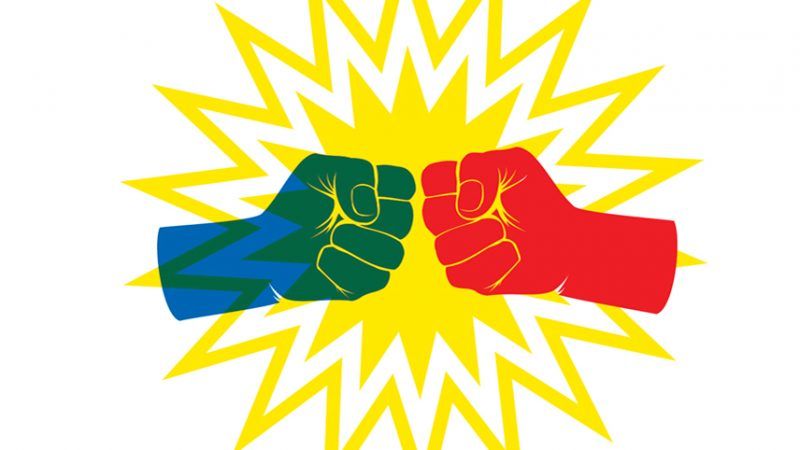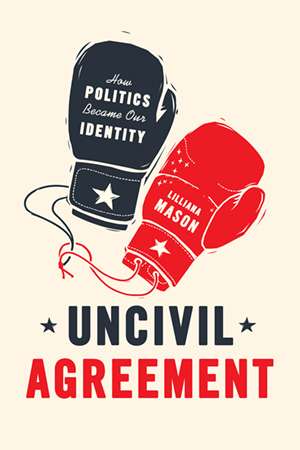Do Partisans Hate Each Other More Than Ever?
Scholars try to explain today's political warfare.

Uncivil Agreement: How Politics Became Our Identity, by Lilliana Mason, University of Chicago Press, 192 pages, $20

For all the florid journalistic commentary about voter polarization, extensive empirical studies have shown that the American electorate is no more polarized today than it was in the 1970s. What's changed is that the parties have sorted: Democrats have become more homogeneously liberal, Republicans more homogeneously conservative.
But even taking sorting into account, partisan hostility appears greater than any objective differences on the issues would seem to justify. To explain this divergence, a number of scholars have argued for a view generally known as "affective partisanship." Ordinary Democrats and Republicans may not differ that much on public policy, the argument goes, but they dislike the other side more than they used to, ascribing negative traits to them and even claiming they would be upset if their offspring married someone from the other party.
The latest and arguably strongest contribution to this line of work is Uncivil Agreement by Lilliana Mason, an assistant professor of government and politics at the University of Maryland. But before looking at her findings, I want to note some problems with studies of affective partisanship.
First is the simple fact that the proportion of Americans who admit to having any partisan identity is at an all-time low. When the American National Election Studies began in the 1950s, three quarters of those queried claimed to be either a Democrat or a Republican. In the 2016 study, only about 60 percent did. Commercial polls similarly report that 40 percent or more of Americans today claim to be independents.
Some scholars contend that most independents are closet partisans, a contention that far exceeds the empirical support for it. You do not ordinarily think of an identity as something one denies or hides. It's usually something one affirms, as when Red Sox fans wear their hats and shirts in the hostile confines of Yankee Stadium. Indeed, Samara Klar and Yanna Krupnikov make a strong case in their 2016 book Independent Politics (Cambridge University Press) that a large swath of the electorate today finds the available partisan identities unattractive.
Measurement issues are a second problem. The workhorse variable in affective partisanship studies is the "thermometer" measure: Survey respondents rate individuals and groups according to how warm or cold they feel toward them. To my knowledge, no one has empirically demonstrated that such scores do in fact measure affect. Do I feel warm toward Barack Obama because hearing him speak "sends a thrill up my leg," or because I approve of the policy proposals he offers? Nothing in the thermometer measure provides an answer to that question. The same is true for other measures, such as candidate traits. Do I judge Obama as weak because he drew a red line in the sand and didn't enforce it, or does that judgment arise simply from looking at or listening to him?
A third problem is the notable gap between theory and evidence. Affective partisanship scholars generally ground their analyses in something called "social identity theory." There are many variants of this, but they have in common the contrast between in-group and out-group. In-group members evaluate their compatriots positively, defend the in-group when threatened, and show bias in favor of its members; the opposite holds for the out-group. Yet the data contradict half the theory. American partisans evaluate the opposite party more negatively than they used to, but they don't evaluate their own party more positively. In fact, they seem to be evaluating their own party somewhat more negatively than before too. Emory University political scientist Alan Abramowitz argues that contemporary party identification is "negative partisanship."
One could eschew social identity theory in favor of a simple common-sense argument: As the parties have sorted and become more homogeneously liberal and conservative, the average Democrat disagrees with the average Republican on more issues, and the more we disagree with someone the less we like them. That would also help to explain the rise in independents, who find more to disagree with in both sorted parties. And even ordinary partisans, who are less well-sorted than party elites, might like their own party somewhat less than they used to. But this would not explain why partisan hostility exceeds objective differences on policy issues.
Mason's thesis is that the high levels of partisan hostility that accompany much lower levels of policy disagreement reflect an increased alignment between partisan, ideological, and social identities. It is well-known that there is significant slippage between people's ideological self-classification (liberal, moderate, conservative) and their views on specific issues, especially on the conservative side. That has led some political scientists, such as Donald Kinder and Nathan Kalmoe in Neither Liberal Nor Conservative (University of Chicago Press), to call for banishing the concept of ideology. But Mason doubles down, arguing that issue positions are largely rationalizations and ideology is fundamental.
Social sorting has produced more homogeneous parties, she says. Racial, regional, religious, and geographic identities increasingly align to produce a liberal Democratic Party and a conservative Republican Party. The two groups have different beliefs, different lifestyles, different media preferences, and numerous other differences.
Mason's empirical analyses engage several major databases. One chapter demonstrates that levels of partisan hostility and perception of social differences significantly exceed what issue differences alone would predict, although the latter are important as well. Another chapter demonstrates the critical importance of sorting—highly partisan individuals who are not ideologically consistent are much less hostile to the other party than equally partisan individuals whose partisan and ideological identities reinforce each other. Another chapter, focused on emotion, reports experimental evidence as well as surveys: A researcher in the laboratory can produce feelings, such as anger or enthusiasm, with scripts that invoke threats or pride. Social sorting produces a stronger emotional response than partisan identity alone, and both produce a stronger response than issue extremity.
But the most important finding of the book is the importance of cross-pressures. A key concept in political sociological writing of the mid-20th century, cross-pressures are social cleavages that cut across rather than parallel each other. For example, if religious denomination is independent of social class, and ethnicity is independent of both, politics will be more consensual and a society will be more stable than if, say, all Catholics are working-class and members of a particular ethnic group and all Protestants the opposite. Mason finds that people with cross-cutting identities ("inconsistents") are less hostile toward opposite partisans than are people with moderate issue positions ("centrists"). This also holds true for emotion: "Cross-cutting identities dampen emotional reactions to political messages such that the most cross-cutting identities lead to a complete lack of emotional response. This lack of response exists only in the group of cross-cut citizens that are increasingly disappearing from the American electorate" (my emphasis).
The book's final chapters consider broader issues, such as whether increased participation by intense citizens is a good thing (Mason thinks it isn't), plus the obligatory "Can we fix it?" Answer: probably not. The only real solution that the author sees is some development that leads to a de-sorting of the parties and a resurgence of cross-cutting cleavages.
"Social sorting of the American electorate has been, on balance, normatively bad for American democracy," Mason concludes. "The voting booths are increasingly occupied by those who fiercely want their side to win and consider the other party to be disastrous.…As long as a social divide is maintained between the parties, the electorate will behave more like a pair of warring tribes than like the people of a single nation, caring for their shared future."
This article originally appeared in print under the headline "Do Partisans Hate Each Other More Than Ever?."


Show Comments (233)